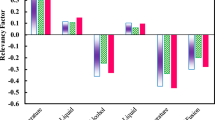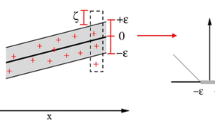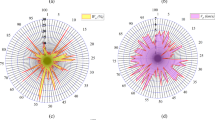Abstract
Precipitation and scaling of calcium sulfate have been known as major problems facing process industries and oilfield operations. Most scale prediction models are based on aqueous thermodynamics and solubility behavior of salts in aqueous electrolyte solutions. There is yet a huge interest in developing reliable, simple, and accurate solubility prediction models. In this study, a comprehensive model based on least-squares support vector machine (LS-SVM) is presented, which is mainly devoted to calcium sulfate dihydrate (or gypsum) solubility in aqueous solutions of mixed electrolytes covering wide temperature ranges. In this respect, an aggregate of 880 experimental data were gathered from the open literature in order to construct and evaluate the reliability of presented model. Solubility values predicted by LS-SVM model are in well accordance with the observed values yielding a squared correlation coefficient (R 2) of 0.994. Sensitivity of the model for some important parameters is also checked to ascertain whether the learning process has succeeded. At the end, outlier diagnosis was performed using the method of leverage value statistics to find and eliminate the falsely recorded measurements from assembled dataset. Results obtained from this study indicate that LS-SVM model can successfully be applied in predicting accurate solubility of calcium sulfate dihydrate in Na–Ca–Mg–Fe–Al–H–Cl–H2O system over temperatures ranging from 283.15 to 371.15 K.









Similar content being viewed by others
Abbreviations
- AAE:
-
Average absolute error (%)
- b :
-
Bias term
- C :
-
Positive constant
- CSA:
-
Coupled simulated annealing
- EOR:
-
Enhanced oil recovery
- H :
-
Hat matrix
- \(K(x,x_{i} )\) :
-
Kernel function
- LS-SVM:
-
Least-squares supported vector machine
- m :
-
Molality
- MSE:
-
Mean-squared error
- NO:
-
Number of training objects
- Q :
-
Solubility of CaSO4.2H2O (m)
- R 2 :
-
Squared correlation coefficient
- RMSE:
-
Root-mean-square error
- R :
-
Residual
- SDE:
-
Standard deviation error
- x :
-
Inputs
- X :
-
A two-dimensional matrix
- ϕ(x):
-
Mapping function
- t :
-
Transpose operator
- T :
-
Temperature (K)
- w :
-
A nonlinear function
- y :
-
Outputs
- ψ :
-
Relative weight of the summation of the regression errors
- α :
-
Lagrange multipliers
- σ 2 :
-
Squared bandwidth
References
Amjad Z (1988) Calcium sulfate dihydrate (gypsum) scale formation on heat exchanger surfaces: the influence of scale inhibitors. J Colloid Interface Sci 123:523–536
Helalizadeh A (2002) Mixed salt crystallization fouling, PhD Thesis, Department of Chemical and Process Engineering, University of Surrey, UK
Shih W-Y, Rahardianto A, Lee R-W, Cohen Y (2005) Morphometric characterization of calcium sulfate dihydrate (gypsum) scale on reverse osmosis membranes. J Memb Sci 252:253–263
Safari H, Jamialahmadi M (2014) Thermodynamics kinetics, and hydrodynamics of mixed salt precipitation in porous media: model development and parameter estimation. Transp Porous Med 101:477–505
Safari H, Jamialahmadi M (2013) Estimating the kinetic parameters regarding barium sulfate deposition in porous media: a genetic algorithm approach, Asia-Pacific. J Chem Eng: n/a–n/a
Jamialahmadi M, Muller-Steinhagen H (2008) Mechanisms of scale deposition and scale removal in porous media. Int J Oil Gas Coal Technol 1:81–108
Moghadasi J, Müller-Steinhagen H, Jamialahmadi M, Sharif A (2004) Model study on the kinetics of oil field formation damage due to salt precipitation from injection. J Petrol Sci Eng 43:201–217
Liu X, Jungang L, Qianya Z, Jinlai F, Yingli L, Jingxin S (2009) The analysis and prediction of scale accumulation for water-injection pipelines in the Daqing Oilfield. J Petrol Sci Eng 66:161–164
Yuan M (1989) Prediction of sulphate scaling tendency and investigation of barium and strontium sulphate solid solution scale formation. Heriot-Watt University, Edinburgh
Binmerdhah AB (2007) The study of scale formation in oil reservoir during water injection at high-barium and high-salinity formation water, M.Sc. thesis, Faculty of Chemical and Natural Resources Engineering, Universiti Teknologi Malaysia, Malaysia
Bedrikovetsky PG, Mackay EJ, Silva RMP, Patricio FMR, Rosário FF (2009) Produced water re-injection with seawater treated by sulphate reduction plant: injectivity decline, analytical model. J Petrol Sci Eng 68:19–28
Li Z, Demopoulos GP (2005) Effect of NaCl, MgCl2, FeCl2, FeCl3, and AlCl3 on solubility of CaSO4 phases in aqueous HCl or HCl + CaCl2 Solutions at 298 to 353 K. J Chem Eng Data 51:569–576
Boerlage SFE, Kennedy MD, Bremere I, Witkamp GJ, Van der Hoek JP, Schippers JC (2002) The scaling potential of barium sulphate in reverse osmosis systems. J Memb Sci 197:251–268
Haarberg T, Selm I, Granbakken DB, Østvold T, Read P, Schmidt T (1992) Scale formation in reservoir and production equipment during oil recovery: an equilibrium model. SPE Prod Eng 7:75–84
Cameron FK, Seidell A (1900) Solubility of gypsum in aqueous solutions of certain electrolytes. J Phys Chem 5:643–655
Kumar A, Sanghavi R, Mohandas VP (2006) Experimental densities, speeds of sound, isentropic compressibilties and shear relaxation times of CaSO4·2H2O + CaCl2 + H2O and CaSO4·2H2O + NaCl + H2O systems at temperatures 30 and 35 °C. J Solution Chem 35:1515–1524
Kochetkova NV, Gavrilov NB, Dergacheva NP, Chudnenko KV, Krenev VA (2006) Physicochemical modeling of precipitating and dissolving of gypsum in chloride solutions. Russ J Inorg Chem 51:823–828
Kumar A, Sanghavi R, Mohandas VP (2007) Solubility Pattern of CaSO4·2H2O in the System NaCl + CaCl2 + H2O and Solution Densities at 35 °C: non-ideality and Ion Pairing. J Chem Eng Data 52:902–905
Kumar A, Shukla J, Dangar Y, Mohandas VP (2010) Effect of MgCl2 on the Solubility of CaSO4·2H2O in the Aqueous NaCl System and Physicochemical Solution Properties at 35 °C. J Chem Eng Data 55:1675–1678
Marshall WL, Slusher R, Jones EV (1964) Aqueous systems at high temperatures XIV. Solubility and thermodynamic relationships for CaSO4 in NaCl–H2O solutions from 40° to 200 °C., 0 to 4 Molal NaCl. J Chem Eng Data 9:187–191
Power WH, Fabuss BM, Satterfield CN (1966) Transient solubilities and phase changes of calcium sulfate in aqueous sodium chloride. J Chem Eng Data 11:149–154
Furby E, Glueckauf E, McDonald LA (1968) The solubility of calcium sulphate in sodium chloride and sea salt solutions. Desalination 4:264–276
Ostroff AG, Metler AV (1966) Solubility of calcium sulfate dihydrate in the system NaCl–MgCl2–H2O from 28° to 70° C. J Chem Eng Data 11:346–350
Wu X, He W, Guan B, Wu Z (2010) Solubility of calcium sulfate dihydrate in Ca–Mg–K chloride salt solution in the range of (348.15 to 371.15) K. J Chem Eng Data 55:2100–2107
Spencer RJ, Møller N, Weare JH (1990) The prediction of mineral solubilities in natural waters: a chemical equilibrium model for the Na–K–Ca–Mg–Cl–SO4–H2O system at temperatures below 25°C. Geochim Cosmochim Acta 54:575–590
Monnin C, Galinier C (1988) The solubility of celestite and barite in electrolyte solutions and natural waters at 25°C: a thermodynamic study. Chem Geol 71:283–296
Møller N (1988) The prediction of mineral solubilities in natural waters: a chemical equilibrium model for the Na-Ca-Cl-SO4-H2O system, to high temperature and concentration. Geochim Cosmochim Acta 52:821–837
Monnin C (1999) A thermodynamic model for the solubility of barite and celestite in electrolyte solutions and seawater to 200°C and to 1 kbar. Chem Geol 153:187–209
Monnin C (1990) The influence of pressure on the activity coefficients of the solutes and on the solubility of minerals in the system Na–Ca–Cl–SO4–H2O to 200 °C and 1 kbar and to high NaCl concentration. Geochim Cosmochim Acta 54:3265–3282
Harvie CE, Weare JH (1980) The prediction of mineral solubilities in natural waters: the Na–K–Mg–Ca–Cl–SO4–H2O system from zero to high concentration at 25° C. Geochim Cosmochim Acta 44:981–997
Oddo JE, Tomson MB (1994) Why scale forms and how to predict it. SPE Prod Oper 9:47–54
Mohammadi AH, Richon D (2007) Thermodynamic modeling of salt precipitation and gas hydrate inhibition effect of salt aqueous solution. Ind Eng Chem Res 46:5074–5079
Pitzer K (1975) Thermodynamics of electrolytes V. effects of higher-order electrostatic terms. J Solut Chem 4:249–265
Pitzer KS (1973) Thermodynamics of electrolytes. I. Theoretical basis and general equations. J Phys Chem 77:268–277
Wang P, Oakes CS, Pitzer KS (1997) Thermodynamics of aqueous mixtures of magnesium chloride with sodium chloride from 298.15 to 573.15 K. New measurements of the enthalpies of mixing and of dilution. J Chem Eng Data 42:1101–1110
Phutela RC, Pitzer KS, Saluja PPS (1987) Thermodynamics of aqueous magnesium chloride, calcium chloride, and strontium chloride at elevated temperatures. J Chem Eng Data 32:76–80
Pitzer KS, Olsen J, Simonson JM, Roy RN, Gibbons JJ, Rowe L (1985) Thermodynamics of aqueous magnesium and calcium bicarbonates and mixtures with chloride. J Chem Eng Data 30:14–17
Pitzer KS, Peiper JC, Busey RH (1984) Thermodynamic properties of aqueous sodium chloride solutions. J Phys Chem Ref Data 13:1–102
Rogers PSZ, Pitzer KS (1981) High-temperature thermodynamic properties of aqueous sodium sulfate solutions. J Phys Chem 85:2886–2895
Shi W, Kan AT, Fan C, Tomson MB (2012) Solubility of barite up to 250 °C and 1500 bar in up to 6 m NaCl Solution. Ind Eng Chem Res 51:3119–3128
Raju KUG, Atkinson G (1989) Thermodynamics of scale mineral solubilities. 2. Strontium sulfate(s) in aqueous sodium chloride. J Chem Eng Data 34:361–364
Raju K, Atkinson G (1988) Thermodynamics of scale mineral solubilities. 1. Barium sulfate(s) in water and aqueous sodium chloride. J Chem Eng Data 33:490–495
Harvie CE, Møller N, Weare JH (1984) The prediction of mineral solubilities in natural waters: the Na–K–Mg–Ca–H–Cl–SO4–OH–HCO3–CO3–CO2–H2O system to high ionic strengths at 25°C. Geochim Cosmochim Acta 48:723–751
Pabalan RT, Pitzer KS (1987) Thermodynamics of concentrated electrolyte mixtures and the prediction of mineral solubilities to high temperatures for mixtures in the system Na–K–Mg–Cl–SO4–OH–H2O. Geochim Cosmochim Acta 51:2429–2443
Monnin C (1995) Thermodynamic properties of the Na–K–Ca–Ba–Cl–H2O System to 473.15 K and solubility of barium chloride hydrates. J Chem Eng Data 40:828–832
Eakin BE, Mitch FJ (1988) Measurement and correlation of miscibility pressures of reservoir oils, SPE annual technical conference and exhibition, (1988 Copyright 1988. Society of Petroleum Engineers, Houston
Gharagheizi F, Eslamimanesh A, Farjood F, Mohammadi AH, Richon D (2011) Solubility parameters of nonelectrolyte organic compounds: determination using quantitative structure–property relationship strategy. Ind Eng Chem Res 50:11382–11395
Cristianini N, Shawe-Taylor J (2000) An introduction to support vector machines: and other kernel-based learning methods. Cambridge University Press, Cambridge
Suykens JAK, Vandewalle J (1999) Least squares support vector machine classifiers. Neural Process Lett 9:293–300
Baylar A, Hanbay D, Batan M (2009) Application of least square support vector machines in the prediction of aeration performance of plunging overfall jets from weirs. Expert Syst Appl 36:8368–8374
Byvatov E, Fechner U, Sadowski J, Schneider G (2003) Comparison of support vector machine and artificial neural network systems for drug/nondrug classification. J Chem Inf Comput Sci 43:1882–1889
Scholkopf BS, Smola AJ (2002) Learning with kernels: support vector machines, regularization, optimization and beyond. MIT press, Cambridge
Vapnik V (1995) The nature of statistical learning theory. Springer, New York
Moser G, Serpico SB (2009) Modeling the error statistics in support vector regression of surface temperature from infrared data. Geosci Remote Sens Lett IEEE 6:448–452
Suykens JAK (2001) Support vector machines: a nonlinear modelling and control perspective. Eur J Control 7:311–327
Smola AJ, SchoLkopf B (2004) A tutorial on support vector regression. Stat Comput 14:199–222
Haifeng W, Dejin H (2005) Comparison of SVM and LS-SVM for regression, neural networks and brain, 2005. ICNN&B ‘05. International Conference on 2005, pp 279–283
Farasat A, Shokrollahi A, Arabloo M, Gharagheizi F, Mohammadi AH (2013) Toward an intelligent approach for determination of saturation pressure of crude oil. Fuel Process Technol 115:201–214
Fazavi M, Hosseini SM, Arabloo M, Shokrollahi A, Amani M (2013) Applying a smart technique for accurate determination of flowing oil/water pressure gradient in horizontal pipelines. J Dispers Sci Technol
Hemmati-Sarapardeh A, Shokrollahi A, Tatar A, Gharagheizi F, Mohammadi AH, Naseri A (2013) Reservoir oil viscosity determination using an intelligent approach. Fuel 116:39–48
Rafiee-Taghanaki S, Arabloo M, Chamkalani A, Amani M, Zargari MH, Adelzadeh MR (2013) Implementation of SVM framework to estimate PVT properties of reservoir oil. Fluid Phase Equilib 346:25–32
Shokrollahi A, Arabloo M, Gharagheizi F, Mohammadi AH (2013) Intelligent model for prediction of CO2–Reservoir oil minimum miscibility pressure. Fuel 112:375–384
Arabloo M, Shokrollahi A, Gharagheizi F, Mohammadi AH (2013) Towards a predictive model for estimating dew point pressure in gas condensate systems. Fuel Process Technol (in Press)
Pelckmans K, Suykens JAK, Van Gestel T, De Brabanter J, Lukas L, Hamers B, De Moor B, Vandewalle J (2002) LS-SVMlab: a matlab/c toolbox for least squares support vector machines, Tutorial. KULeuven-ESAT, Leuven
Corana A, Marchesi M, Martini C, Ridella S (1987) Minimizing multimodal functions of continuous variables with the simulated annealing algorithm. ACM Trans Math Softw 13:262–280
Xavier-de-Souza S, Suykens JAK, Vandewalle J, Bolle D (2010) Coupled simulated annealing. IEEE Trans Syst Man Cybern Part B Cybern 40:320–335
Butler JN (1964) Ionic equilibrium: a mathematical approach. Addison-Wesley, Reading
Rousseeuw PJ, Leroy AM (2005) Robust regression and outlier detection. Wiley, Hoboken
Gramatica P (2007) Principles of QSAR models validation: internal and external. QSAR Comb Sci 26:694–701
Rousseeuw PJ, Leroy AM (2005) Robust regression and outlier detection. Wiley, Hoboken
Author information
Authors and Affiliations
Corresponding authors
Rights and permissions
About this article
Cite this article
Safari, H., Gharagheizi, F., Lemraski, A.S. et al. Rigorous modeling of gypsum solubility in Na–Ca–Mg–Fe–Al–H–Cl–H2O system at elevated temperatures. Neural Comput & Applic 25, 955–965 (2014). https://doi.org/10.1007/s00521-014-1587-z
Received:
Accepted:
Published:
Issue Date:
DOI: https://doi.org/10.1007/s00521-014-1587-z




